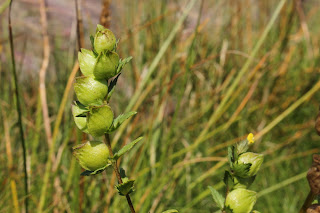Plants are a very diverse group of organisms, so as one could expect, there are a number of them that do "weird" things. There is no shortage of fascinating techniques that plants employ in order to survive in their environment. This is part 2 of my little series "Plants That Do Weird Things". Check out part 1, where we look at myco-heterotrophy, if you haven't already, as it will explain certain concepts that I refer to here.
With this post, we will dive into haustorial parasites. In plants, there are two types of heterotrophs: myco-heterotrophs and haustorial parasites. The term "haustorial parasite", henceforth referred to simply as parasite or parasitic plant, comes from the organ all parasitic plants possess, the haustorium, which is a root-like structure. Fungi also have this structure, but for our purposes, we will be focusing on haustoria in parasitic plants.
Parasitic plants get some or all of their nutrients from other plants. These parasites use their haustorium to penetrate the host plant, and they may either attach themselves to the root or the stem. In order to extract the required water and nutrients, the parasite connects with the conductive tissue of the plant, either the xylem (transports water and nutrients from the roots to the stem and leaves), the phloem (transports products of organic materials made during photosynthesis, such as sugars, to other parts of the plant), or both.
Much like myco-heterotrophs, there are both "full" and "partial" parasites. In regards to parasitic plants, these are typically referred to as either hemiparasites (both parasitic, and able to complete photosynthesis), or holoparasites (obtains all nutrients from a host plant, often lacks chlorophyll). It is important to note that neither hemiparasites or holoparasites are inherently more parasitic than the other, they just are able to perform different functions.
Another important distinction is whether a parasite is obligate or facultative. With obligate parasites, they require a host plant to complete their life cycle. On the contrary, with a facultative parasite, it is not imperative that a host plant is present, as it is able to complete its life cycle regardless, taking advantage of a host if the opportunity arises. A hemiparasite can be either obligate or facultative, but a holoparasite can only be obligate.
As one can imagine, parasitic plants needs to germinate close to their host plant, especially in the case of obligate parasites. Parasitic plants can germinate either using chemical or mechanical mechanisms, and is often dependant on which part of the plant it parasitizes—the root or the stem. In the case of root parasites, seeds must land very close to the host, as they receive a chemical signal from said host, leached from the root system into the surrounding soil, which initiates germination. Unlike root parasites, stem parasites are able to germinate and then survive for some time as they try to find a host using resources from the seed endosperm (tissue inside the seed that is able to provide nutrients to the embryo).
While worldwide there are approximately 4500 species of parasitic plants spanning 20 families, in Ontario, where our focus lies, there are only three families that have parasitic members.
Perhaps the most well known family is the broomrapes (Orobanchaceae). This is a unique family in that it features both hemiparasites and holoparasites. It also has a few non-parasitic genera, but these do not occur in Ontario.
One-flowered Cancer-Root (Aphyllon uniflorum) is the more widespread of the two Aphyllon species (formally Orobanche) in Ontario. It is an uncommon species that is always a joy to come across. This is a holoparasite, with its host being the aster family (Asteraceae), saxifrage family (Saxifragaceae), and the stonecrops (Sedum). In the below photo, you will see an abundance of goldenrod (Solidago spp) leaves, which are likely hosting this particular plant.
Another holoparasite in the broomrape family is Bear Corn (Conopholis americana). This is a root parasite of woody plants, in particular oaks (Quercus spp) and beeches (Fagus spp).
 |
| From Wikimedia |
 |
| Scarlet Painted-cup (Castilleja coccinea) |
 |
| Canadian Wood Betony (Pedicularis canadensis) |
 |
| Eyebright (Euphrasia spp) |
 |
| Yellow Rattle (Rhinanthus minor) |
 |
| Red Bartsia (Odontites vernus) NOTE: non-native |
 |
| Purple False Foxglove (Agalinis purpurea) |
The last member of this family is a bit more of a cryptic species (I have never seen it in the flesh, aside from one very poor herbarium specimen), but may have a familiar name. That species is Eastern Dwarf Mistletoe (Arceuthobium pusillum). Its hosts are a variety of conifers: Black Spruce (Picea mariana), White Spruce (Picea glauca), Red Spruce (Picea rubens), Norway Spruce (Picea abies), Blue Spruce (Picea pungens), Jack Pine (Pinus banksiana), Eastern White Pine (Pinus strobus), Red Pine (Pinus resinosa), Balsam Fir (Abies balsamea), and Tamarack (Larix laricina). While this is a hemiparasite, it is obligate, and borders on being a holoparasite. Once the seed lands on the host branch, it germinates and is completely dependant on the host for nutrients. It is not until the mistletoe grows stems that it is able to photosynthesize. Even then, this plant possess very little photosynthetic ability, and draws heavily on its host. Because of this, dwarf mistletoe is considered a pest and can be very damaging to forests. That being said, it does not spread very fast, so is not invasive.
 |
| Arceuthobium pusillum by Joesph O'Brien |
 |
| Common Dodder |






👍🏻
ReplyDelete